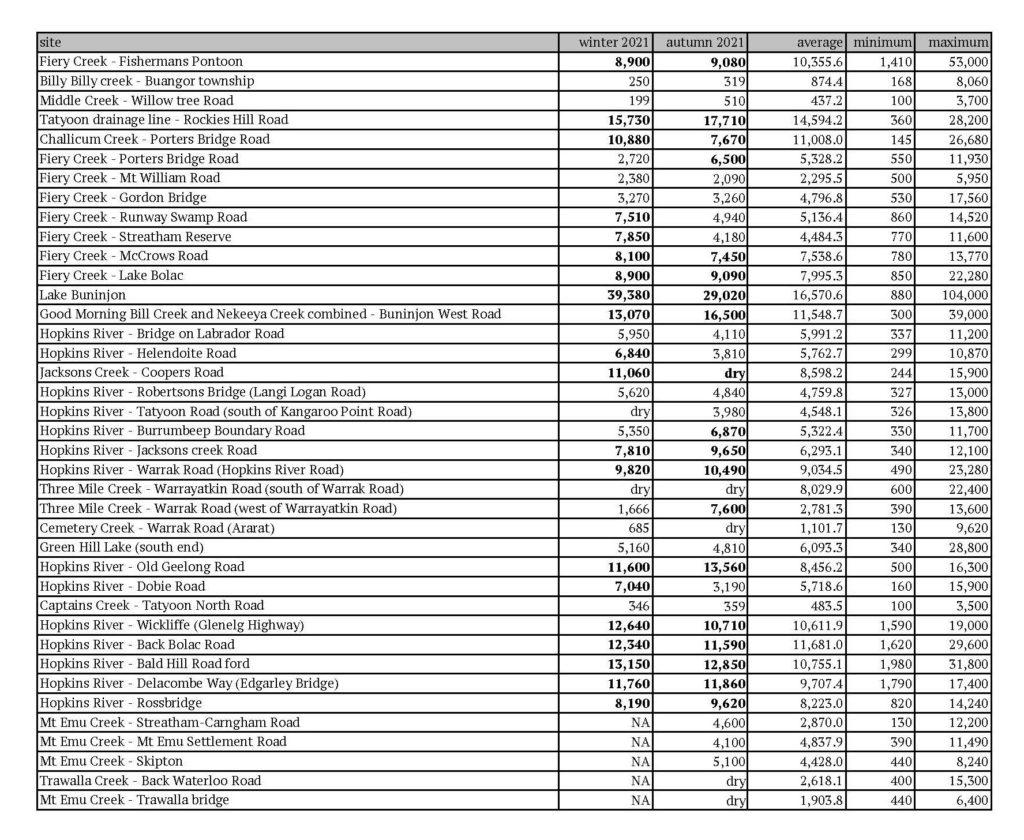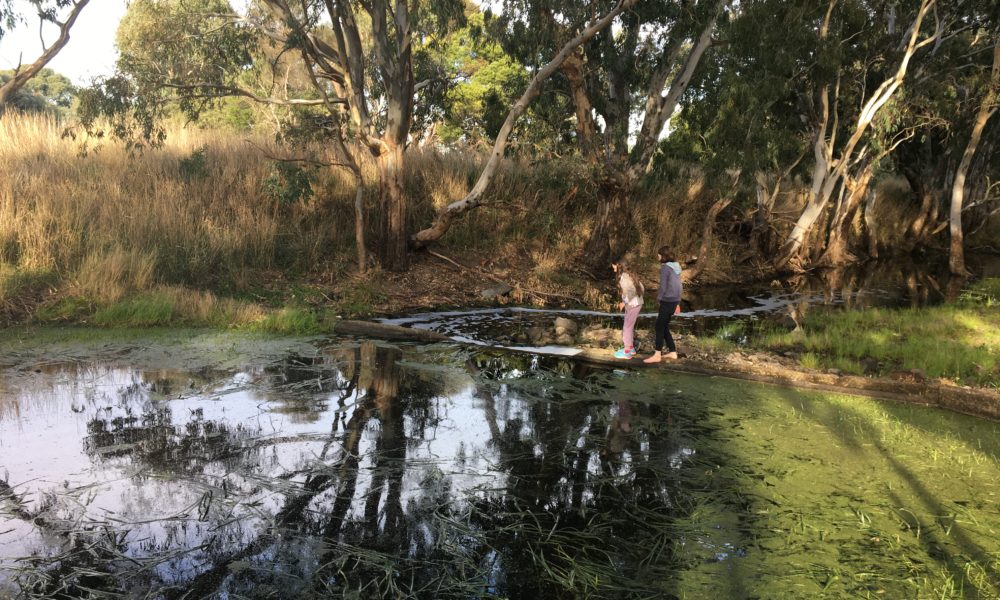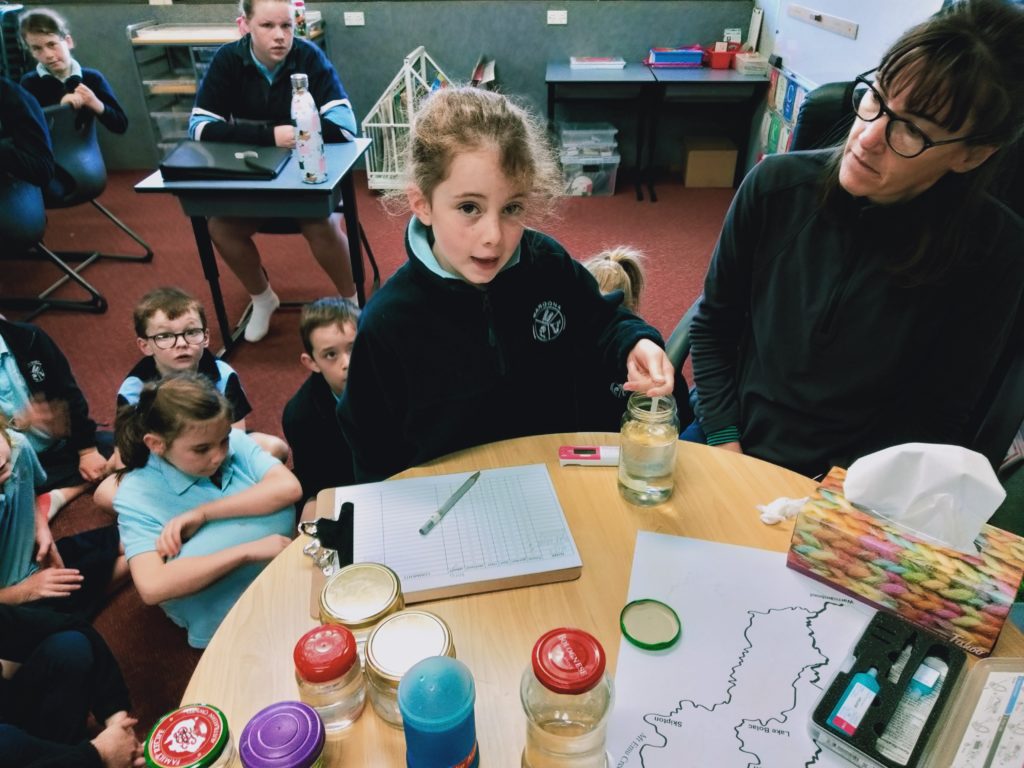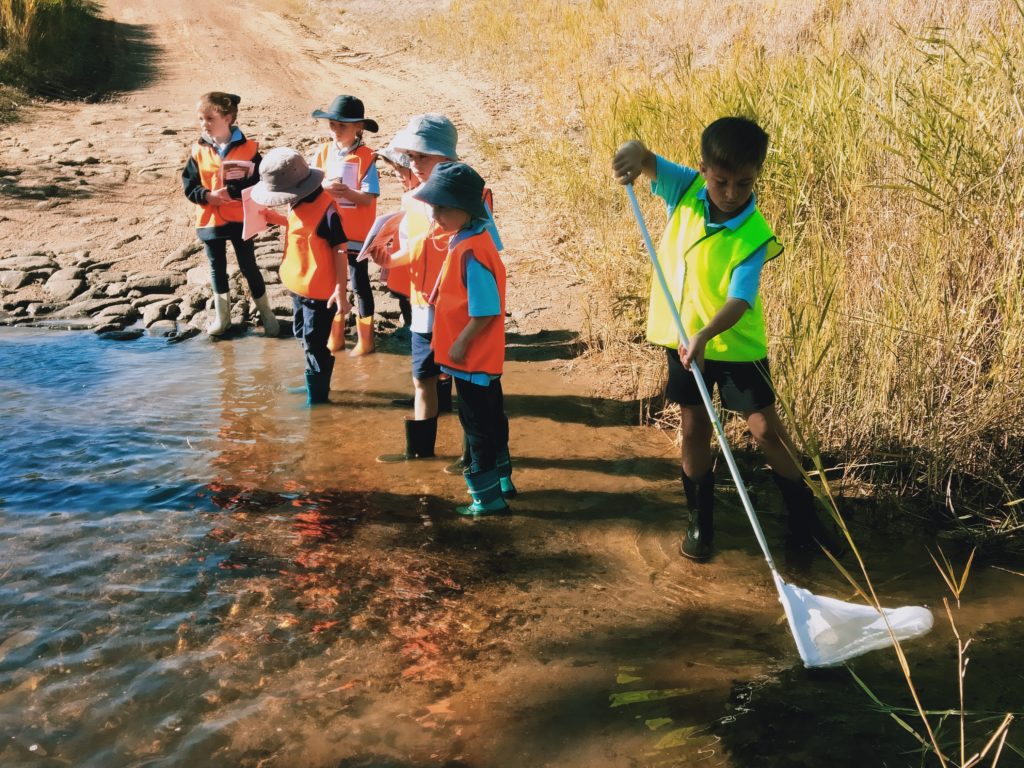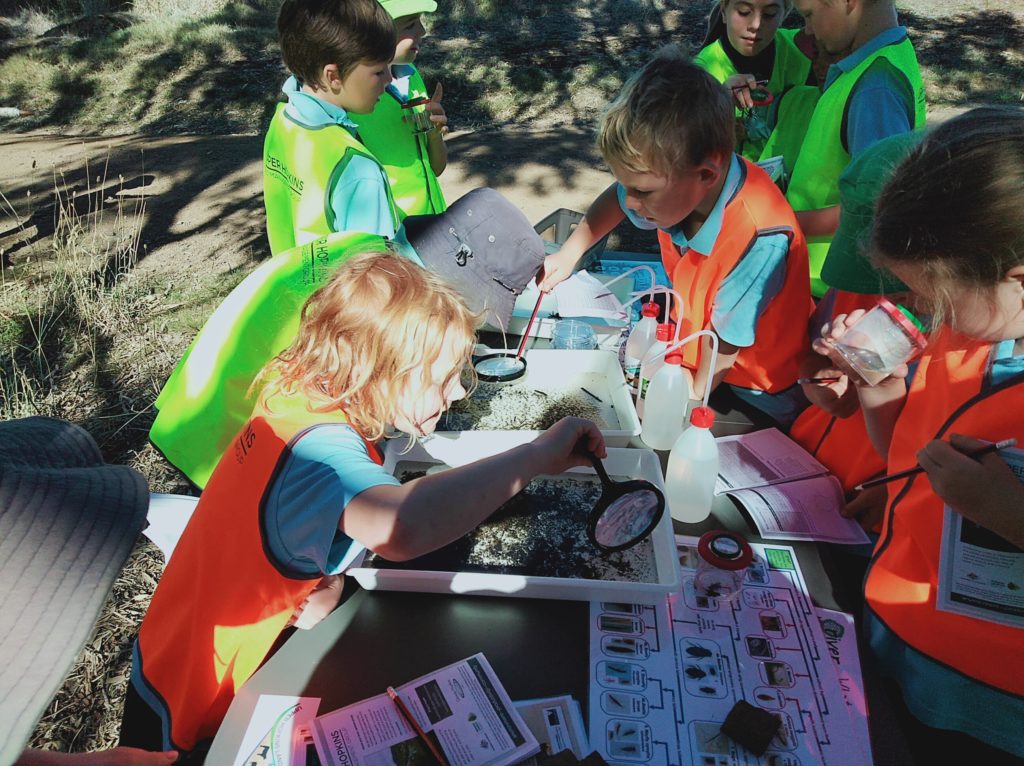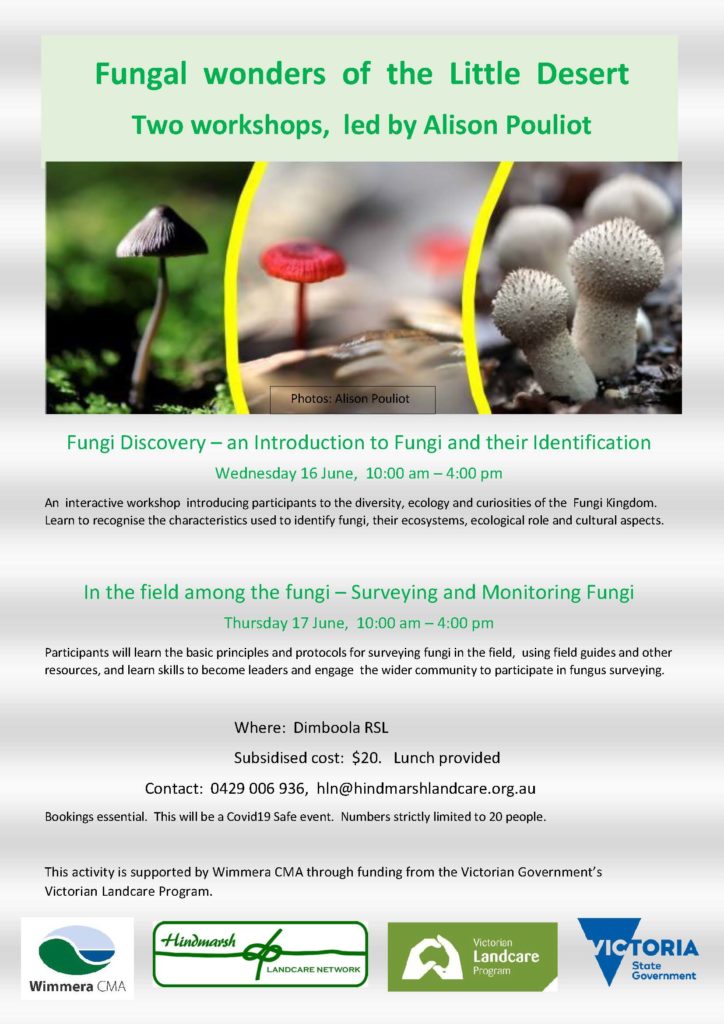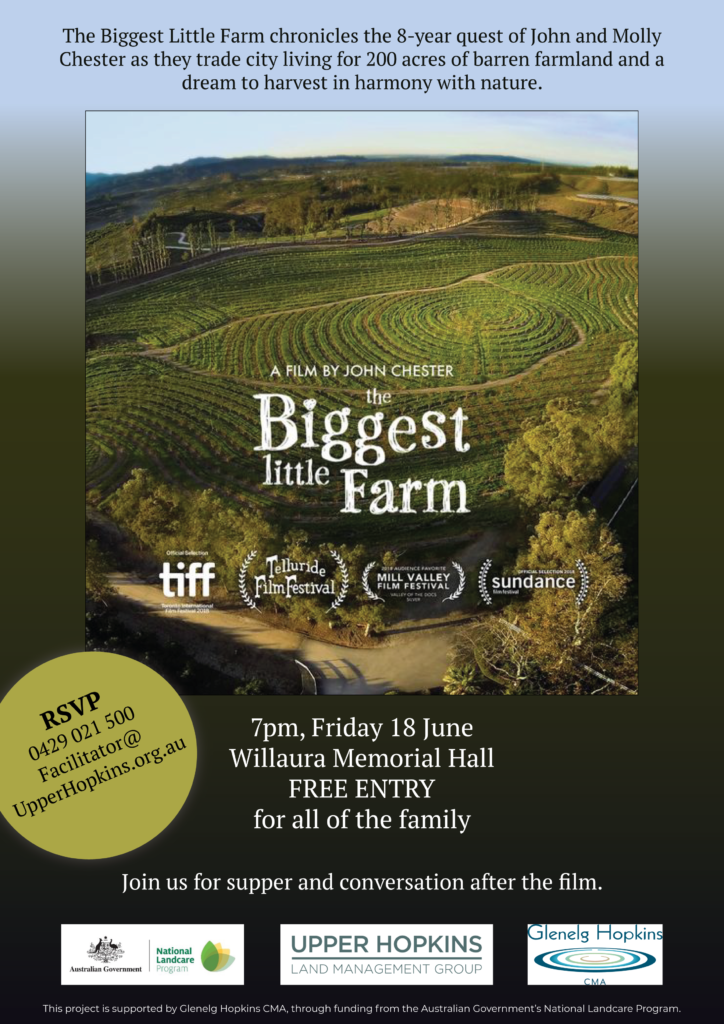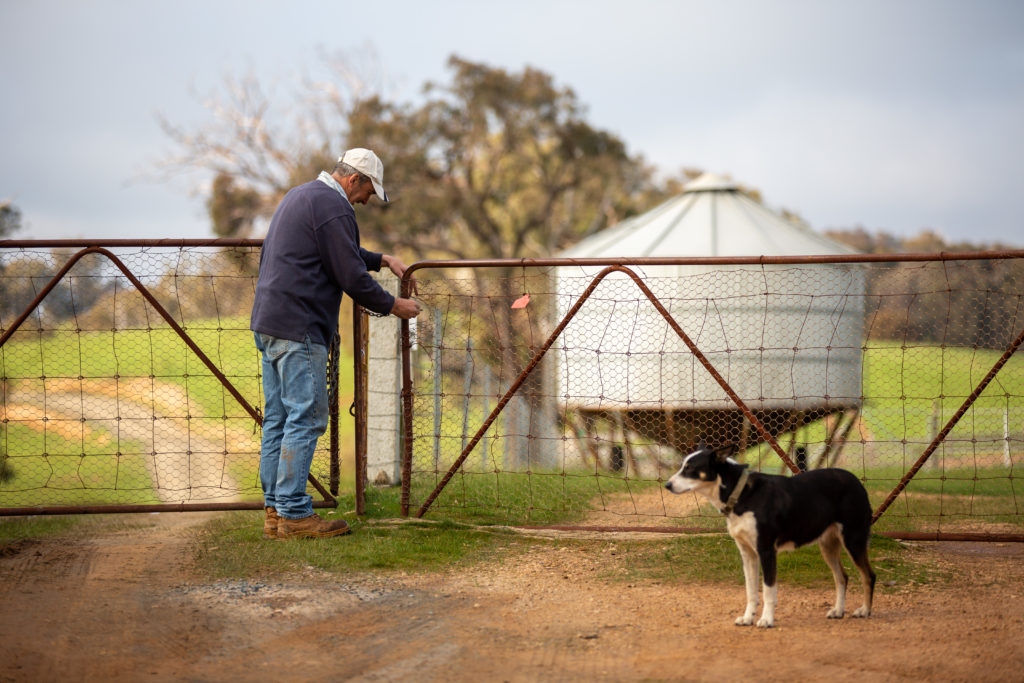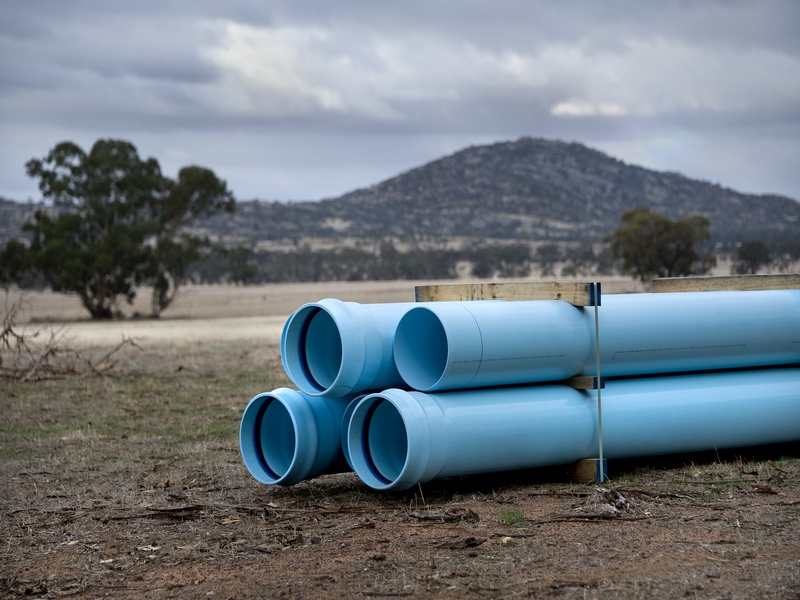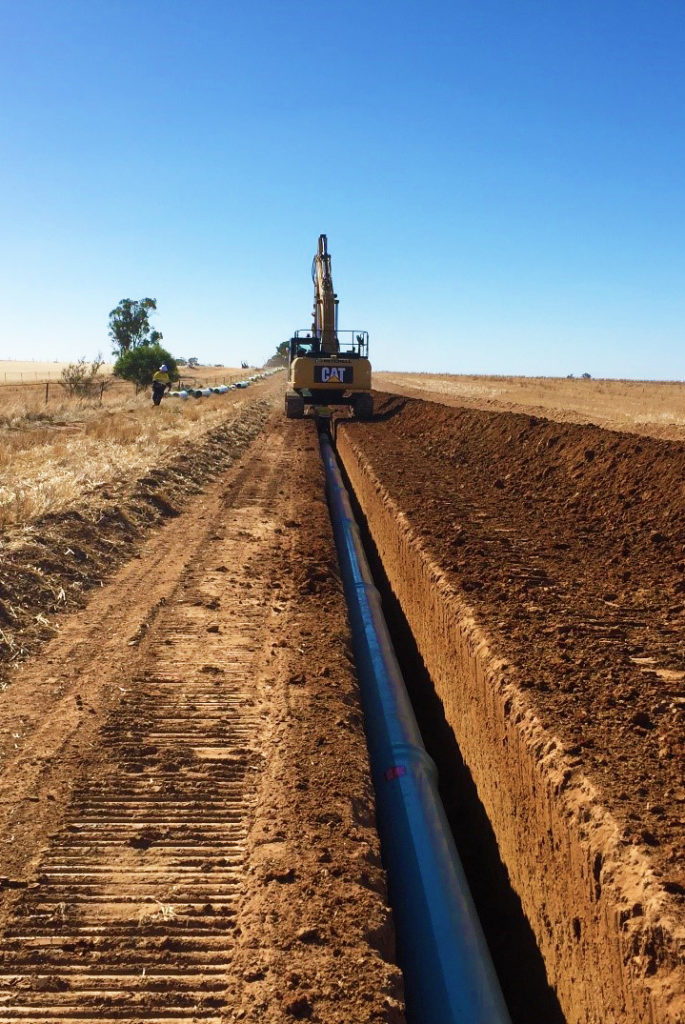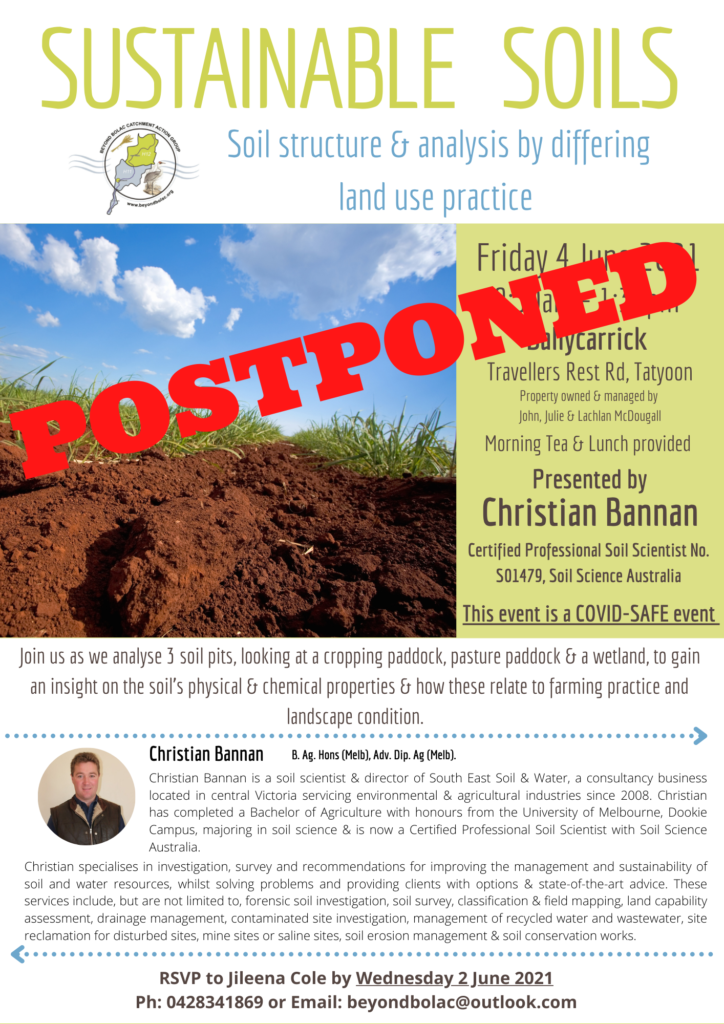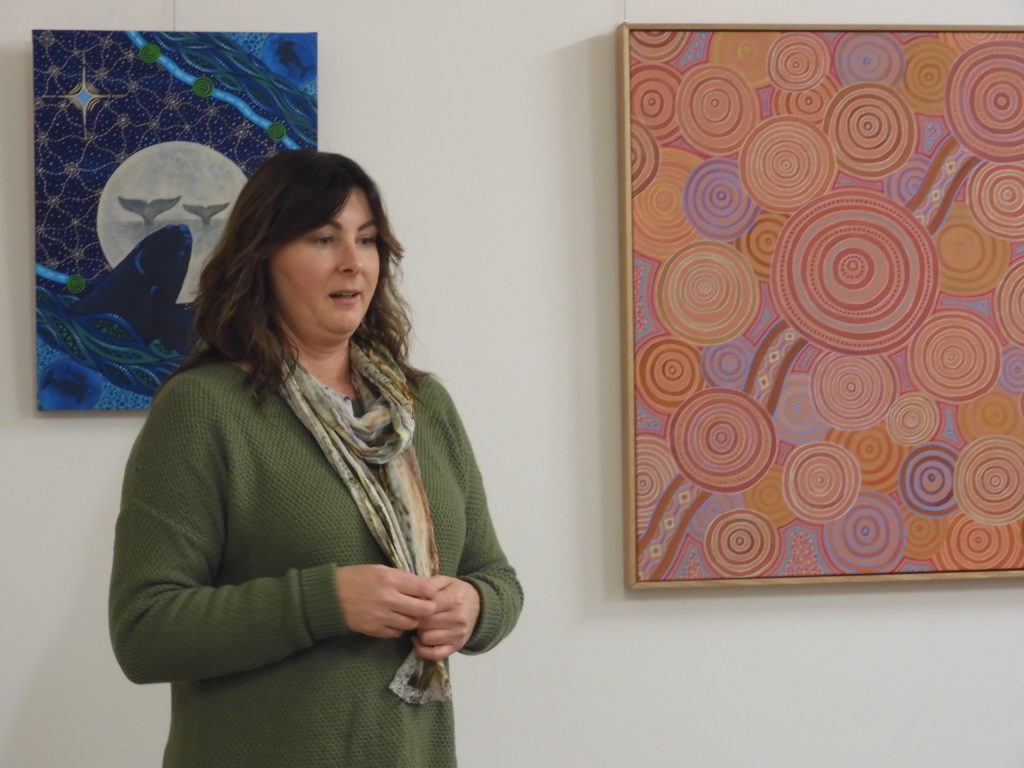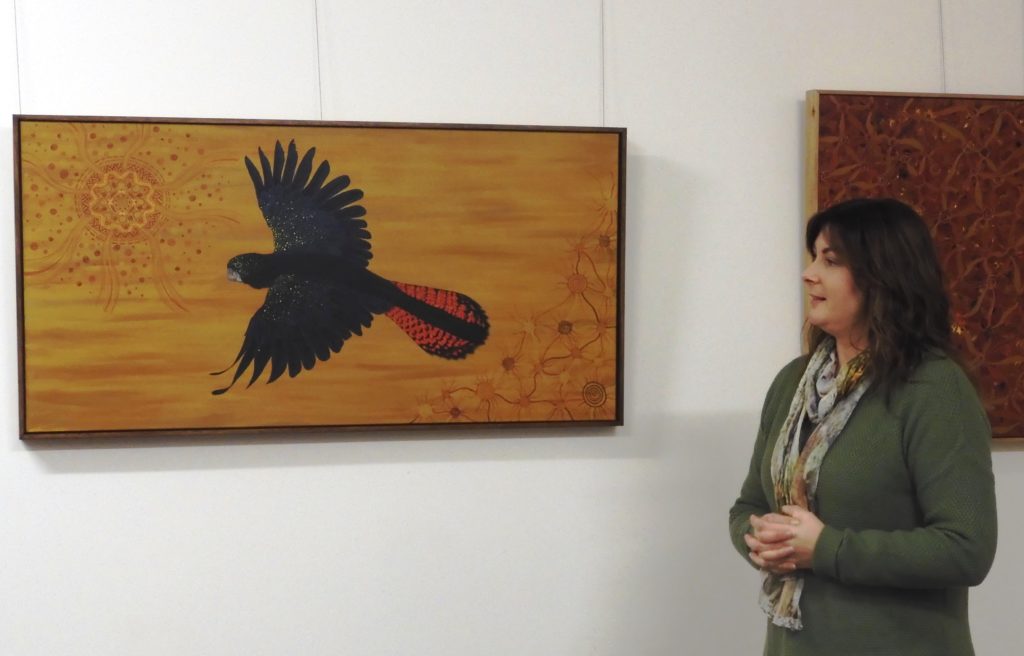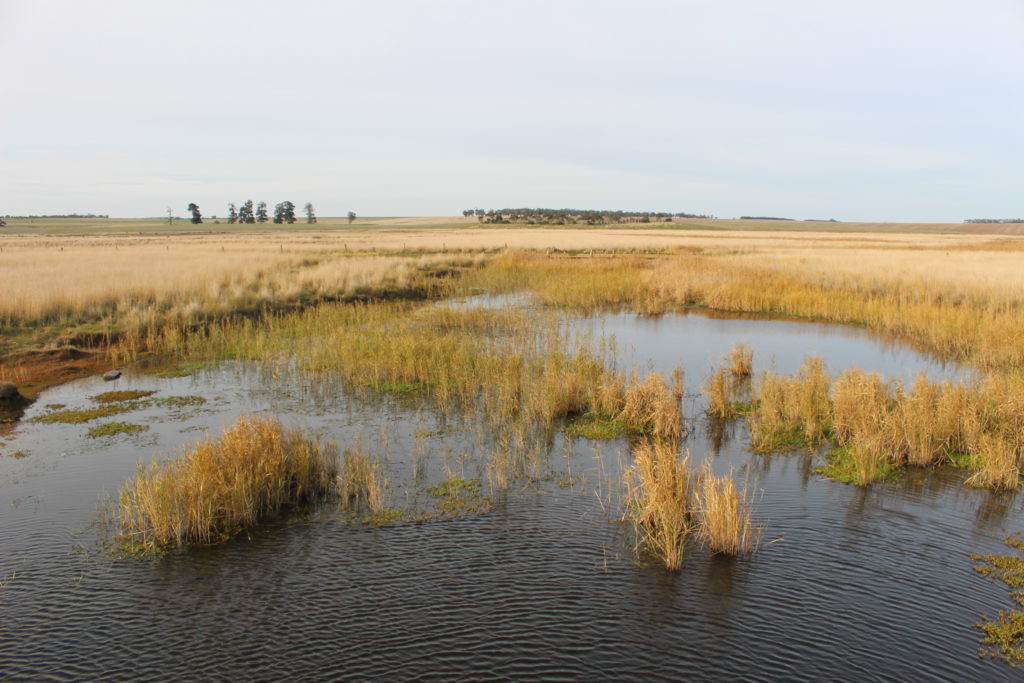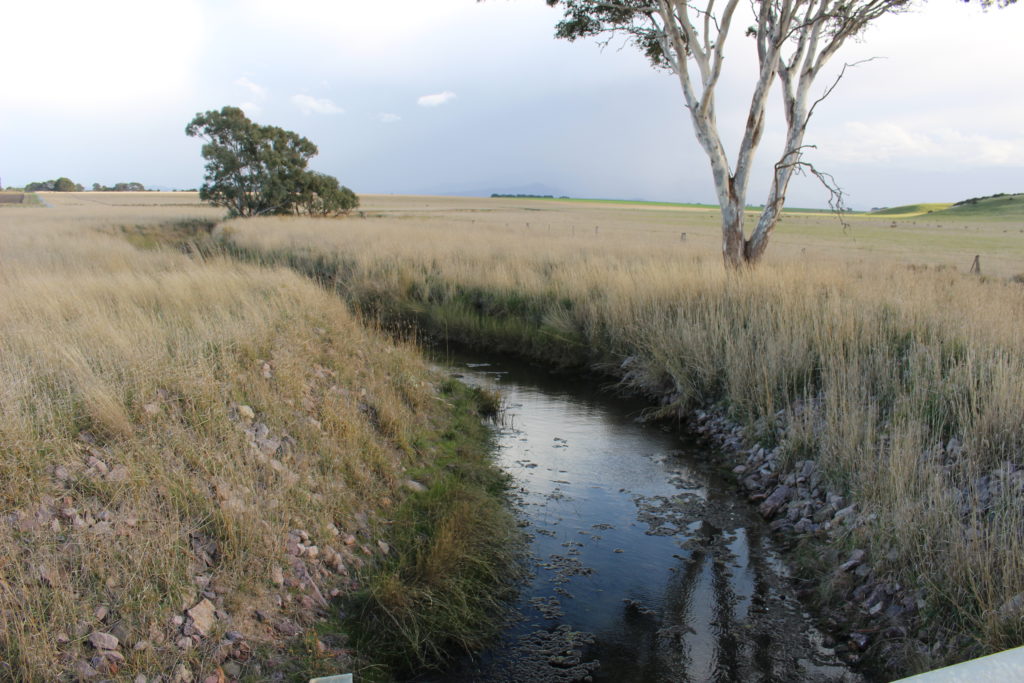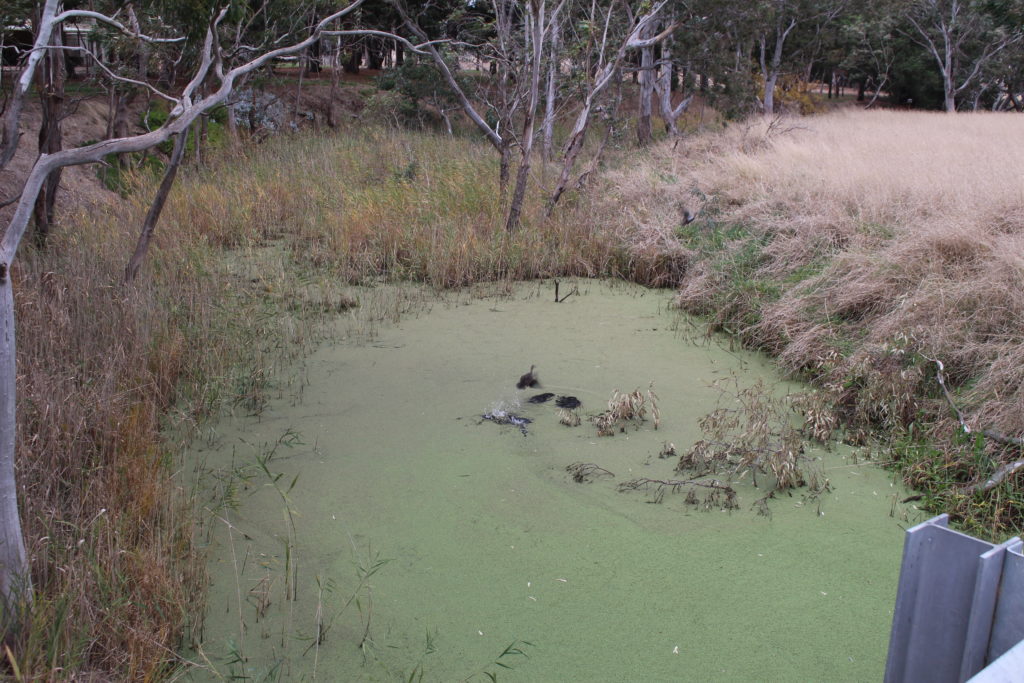Landcare news and opportunities
Opportunities and awards
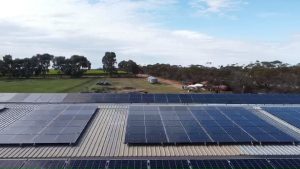
- Big grants for farmers to go solar: Victorian farmers have a great opportunity to apply for substantial grant funding to improve the energy efficiency of their on-farming activities through Agriculture Victoria. The Agriculture Investment Plan has $30 million to support farmers with initiatives like solar power, battery storage and equipment upgrades. For more information, go to: https://mash.org.au/big-grants-for-farmers-to-go-solar/
- 2021 Victorian Landcare Grants: Now is your chance to apply for funding to support a Landcare project on your property. Grant applications must be submitted before 16 June – contact Facilitator@UpperHopkins.org.au immediately if you have an idea for a project. More details about the funding: https://www.environment.vic.gov.au/grants/victorian-landcare-grants
Information and Resources
- Submit your weeds photos for identification: Help Weeds Australia to train a new weeds identification application by submitting your weeds photos. Get involved at https://weeds.org.au/identify/weeds-photo-submissions/
- Do you have drooping sheoaks? Learn more about these majestic trees here: https://www.recreatingthecountry.com.au/blog/drooping-sheoaks-connecting-with-nature-one-plant-at-a-time
- Farm-scale natural capital accounting: This is an interesting read about natural capital accounting and incorporating your farm’s natural natural assets on the balance sheet. Natural capital accounts complement financial accounts to provide an expanded view of farm profits that incorporate changes in natural capital. Read more at: https://www.ecolsoc.org.au/news/farm-scale-natural-capital-accounting/
- Five things the world is saying about ecosystem restoration: The UN Decade on Ecosystem Restoration – set to launch during World Environment Day on 5 June – aims to rally citizens, governments and corporations around one common goal: preventing, halting and reversing the destruction of natural spaces.
- New soil hub from Meat & Livestock Australia: Wanting to learn more about healthy soils and sustainable soil management? Meat and Livestock Australia’s new soil hub is filled with resources to guide you. Go to https://www.mla.com.au/extension-training-and-tools/feedbase-hub/healthy-fertile-soils/
- How to report insect pests for identification: This is a handy guide from cesar Australia that explains how to take good photos, record data and submit your pests for identification. It’s pretty easy! https://cesaraustralia.com/pestfacts/how-to-report-2021/
- Weeds Australia is a relatively new website, consolidating and building on information from older national websites, and powered by the Centre for Invasive Species Solutions (CISS). You can access it here: https://weeds.org.au/
- VICFLORA (Flora of Victoria) by Royal Botanic Gardens Victoria: This is a free online guide to the wild plants of Victoria, and includes plant profiles, identification tools, distribution maps and great photos and illustrations. It is aimed at land managers, scientists, students and anyone with an interest in Victorian plants. You can access the VICFLORA website at: https://vicflora.rbg.vic.gov.au/
- Lucid Weeds of Australia Fact Sheet Index: Originally developed with CRC Weed Management and updated by Queensland Herbarium, it is a wealth of weedy information and images. Go online: https://keyserver.lucidcentral.org/weeds/data/media/Ht ml/index.htm.
- The “Early invader weeds update” is the newsletter of the Weeds at the Early Stage of Invasion (WESI) Project. It is about managing early invader environmental weeds in Victoria. To receive these updates via email, register online at: https://www.eventbrite.com.au/e/subscribe-free-to-early-invader-weeds-update-wesi-newsletter-tickets-111894349010
Webinars and podcasts
- Taking weed photos on your mobile device: Learn the secrets to take better weed photos to help with identification. Apparently, the trick is to know what parts of the weeds to take photograph. Watch this webinar about weed management after fire (jump to weed photography at 33 minutes): https://tinyurl.com/WeedsAfterFire
- Carbon Forum featuring Wilmot Cattle Co.: Watch the online webinar, where Stuart Austin of Wilmot Cattle Co. shared his blueprint for success leading up to the $500,000 sale of carbon credits to Microsoft. https://www.maiagrazing.com/carbon-credits-forum/
- Stubble management can be a complex issue for farmers. Stubble retention has well-documented benefits, including nutrient recycling, reduced erosion, improved rainfall infiltration and reduced moisture evaporation. Retaining stubbles also improves soil health and biology. Watch this webinar from Agriculture Victoria: Stubble, Straw and Carbon – Panels, pellets and alternative uses
- Short webinars about invertebrate pests and their management: I’ve been enjoying this series from cesar Australia. Take a look at all of the recordings online. https://www.youtube.com/channel/UCDo2WwViVkyfUloB6tForQw
- Climate Action through our Food: A climate-ready and carbon neutral food production sector is vital to the future of Australia’s food security and economy. Register for the webinar through the University of Melbourne: https://unimelb.zoom.us/webinar/register/8416219154040/WN_N9b-kuHrRUaMe4gwJREcUg

From the President’s Desk

Jack Tucker, President
Welcome to the Winter edition of our newsletter and another big thankyou to our facilitator Ayesha for doing such a great job once again!
We are in an interesting situation with members at the Southern end of the group verging on too wet, while the Northern end would book in a wet winter if they could.
Despite being dry in the Northern part of the group, mild conditions on top of the green summer have meant that both flora and fauna have thrived. I’m sure anyone who spends time either working in, or just observing the great outdoors would have noticed in recent times how healthy and vibrant farm ecosystems are after two incredible growing seasons! From tiny invertebrates all the way through to Wedge Tailed Eagles, it is exciting to see natures response to a couple of good years!
One way we can enhance and provide stability to our farm eco systems is through revegetation works. We are fortunate at this point in time to be witnessing a lot of the early reveg works throughout the area reaching maturity and really flourishing. Over time it has become abundantly clear that farm reveg work significantly increases overall biodiversity, and has allowed existing isolated populations of many species of birds, mammals and reptiles to move through the landscape via wildlife corridors and inhabit new areas.
If anyone is considering a Landcare project and would like some financial assistance, please contact Ayesha with details of your project, she will be submitting a grant application on behalf of the group in the near future.
As always, I like to remind everyone that new members are always welcome!
Happy Landcaring!
Jack
It’s an exciting time for soil

Richard Murphy, Land Health Coordinator
Since the Australian Government’s appointment of a National Soils Advocate in 2012, awareness of the importance of soil at the national level has been growing. This has been good news for rural areas like the Glenelg Hopkins CMA region, where most people, directly or indirectly, rely on a prosperous agricultural industry for their employment, and these industries rely on soil.
We need only recall the dust storms that blanketed Melbourne in 1983 and 2020 to be reminded that soil loss is a real, and on-going, problem in Australia.

Glenelg Hopkins CMA has always taken seriously our role in helping farmers gain the knowledge and skills to best manage their soils within productive and profitable farming systems. Of Australia’s 55 Natural Resource Management regions we have been one of the few to have a Soil Health Strategy.
This month the Australian Government unveiled a National Soil Strategy. For someone who has worked to promote soil as a fragile and finite natural resource, this event is perhaps the most exciting moment of my career and I want everyone to know about it.
The National Soils Strategy provides a, much needed, framework that supports coordinated action by national and state governments, research institutions, industry and community for the protection and improvement of soils. Underlying the Strategy is the National Soil Monitoring Program, will enable information on soils to be better maintained, more easily accessed and shared.
But that’s not all! By June 2022, a National Soil Strategy Action Plan will be developed that will detail the specific actions and programs needed to achieve the objectives of the Strategy.
But wait, there’s more! With money so often the missing link between plans and action, the 2021–22 Budget included $233.6 million to improve and protect Australia’s soil. What? Am I dreaming? This massive investment will ensure good intentions will become great outcomes.
Want to know more? Click HERE to check out the new National Soils Strategy. To learn more about why this is so awesome, make yourself a cuppa and give me a call on 0407 516 532 and let me explain.
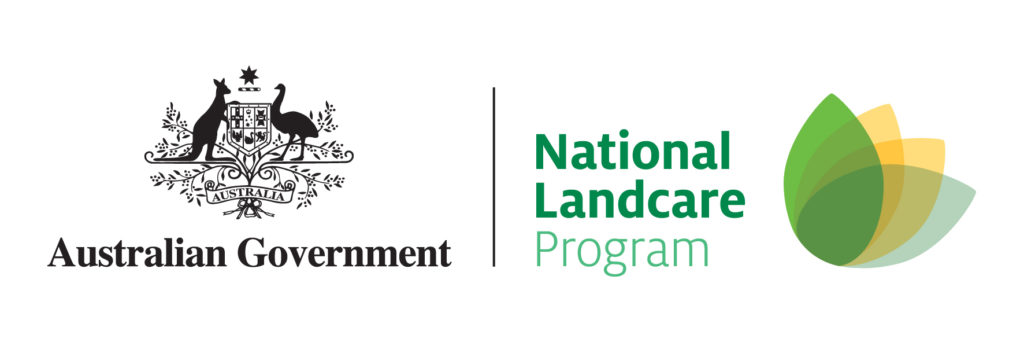
The Glenelg Hopkins Sustainable Agriculture project is supported by the Australian Government’s National Landcare Program.
Measuring economic benefits from planting native vegetation on sheep farms in Western Victoria

Dr Penelope Greenslade, Honorary Research Fellow
I study invertebrates, particularly soil living creatures, and the impact of human activities on the native Australian species with the aim of minimising any damage to them. Some of the impacts I have worked on are broadacre agriculture, stock grazing, forestry and fire. A local farmer, Susan Moodie, who runs a farm at Burrumbeet near Ballarat using conservation principles, wanted to know whether her plantings of native vegetation around fodder crops had benefits for the crop. The wide range of native trees and shrubs she planted should provide habitat for native predators and parasitoids, which could then move into the adjacent Lucerne paddock and reduce pests there. Spiders, mites, beetles and wasps are known natural enemies of the common pests of Lucerne which are the Lucerne flea (Sminthurus viridis) and the mites, Red legged earth mite (Halotydeus destructor) and Blue Oat mite (Penthaleus majer). Susan asked me to carry out fieldwork to find out.
I was fortunate enough to obtain a small amount of funding from the Wettenhall Group to pay for a field assistant to carry out the work, which we did over more than a year from early 2019 to late 2020. The imponderables entailed with this kind of work are that the natural environment, as you farmers would know, is unpredictable and variable not only from season to season but also from year to year and day to day as well. So, fieldwork had to be flexible.
We needed to sample air-borne and ground-active creatures at various distances from the native corridor and so a varied range of collecting techniques were used. We decided to use pitfall traps of various sizes to catch ground active invertebrates and yellow pan traps to catch those moving or blowing around close to the ground. For those flying above the lucerne crop, up to two metres, we used tent-like Malaise traps and yellow sticky cards. Lastly, we also used suction samples to collect invertebrates living on the lucerne crop and sweeps with a linen net to collect from the crop over a larger area than the suction sampler could. The traps were set out every 50 m at right angles to the native corridor (shelter belt) edging the paddock and within it up to 200 m from it. Altogether, we made eight visits to the farm.
What did we find? Firstly, we found each of our methods collected a different range of species, with some overlap. Few pests were recorded on lucerne and no damage was observed on any of our eight visits. Although numerous Cabbage White Butterflies were seen fluttering over the Lucerne, few seem to be landing and laying eggs and hardly any caterpillars were collected or damage observed. Neither were any clover springtails caught and pest mites were found in large numbers only once in a patch 100 and 150 m from the native corridor. Other pests such as myrid bugs and thrips were caught but in low numbers. On the other hand, predatory spiders were present throughout the paddock in reasonable numbers and a few predatory rove beetles were also present. The most abundant predators were Iridomyrmex ants, an omnivorous genus. They were active on the ground as were the spiders.
Native plants were growing vigorously in the native corridor with different species flowering on each of our visits. We found a more varied fauna there including parasitoids but they did not seem to be moving out of the native corridor into the lucerne. So, Susan’s efforts to encourage conservation of native fauna was succeeding but it did not, from our fieldwork, seem to be having any effect on the fodder crop. This is not to say that this corridor did not impose some economic benefit to the farm in terms of wind protection to stock at times of vulnerability such as at lambing.
We would recommend that native corridors such as this one, could, with benefit, be expanded so that they are connected with other native vegetation on the property such as remnant vegetation around dams and swamps. Also, exotic grasses should be eliminated and replaced with local native grass species to provide habitat for those native invertebrates that are grass living. In summary, our results suggest that to expect native species to exert some control of pests in a crop on a farm is unlikely as nearly all are adapted to a native habitat so will not move actively out of native vegetation into an alien one. However our results strictly only apply to Susan’s farm at Burrumbeet and, more specifically, to a crop such as lucerne.

Malaise trap located in the native vegetation edge of a lucerne paddock. 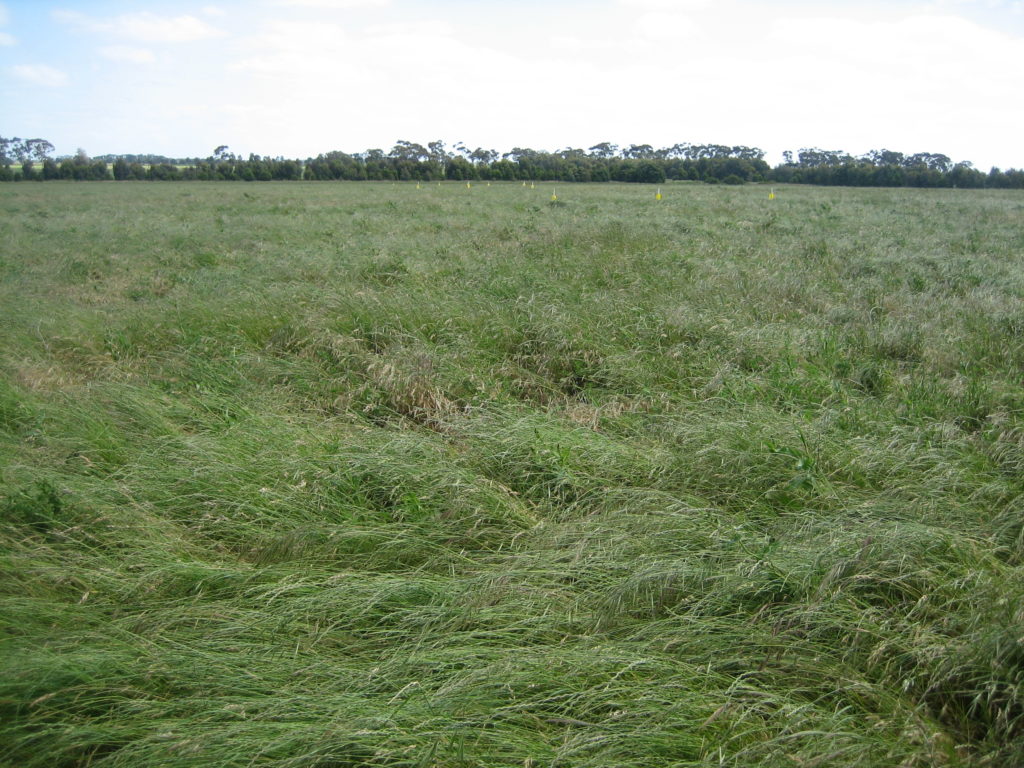
Lucerne paddock with yellow sticky card traps in the distance. 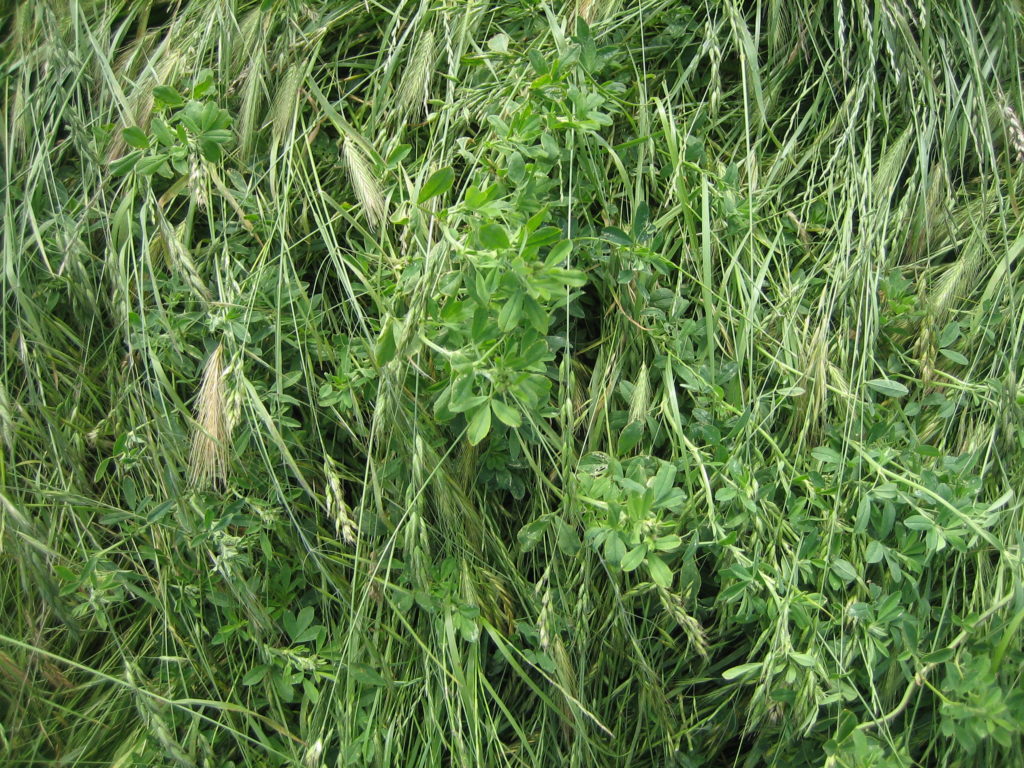
Close up of ground cover in lucerne paddock.
Keringle Native Nursery – now open!
Allison Barr, Keringle Native Nursery
Keringle Native Nursery is a brainchild of mine with my dream becoming a reality in April 2021 to grow and sell native trees and plants to farmers and the wider community.
We are situated on our farm at 199 Gordons Bridge Road, Yalla-Y-Poora which is about half an hour from Willaura, Ararat, Skipton and Beaufort. For most people this is only a small drive and provides an opportunity for people to look at plants in a relaxed farm setting.
The large selection of native plants are all grown from seed and transplanted into tube stock for purchase while others can be bought in pots. Flowering native annuals and perennials are also available for purchase in tube stock and pots.
For the last two years, I have worked and trained under Peta Watson, a former Yalla-Y-Poora resident, who is a horticulturist at Ballarat TAFE. We worked together to supply Ballarat’s Avalon Nursery with natives, and once Peta moved away, I decided to take on the business and re-purpose it to accommodate gardening enthusiasts direct on my farm.
I am meeting the demand from farmers for tree plantations and have planted small and medium plantations for people to peruse and see how they grow and how to plant them.
Keringle Native Nursery is open Monday to Friday, 9am -3pm. Orders can also be made over the phone on 0428 370 353.

Upper Hopkins LMG – Secretary’s report

Celia Tucker, Secretary
These frosty mornings and sunny days we are currently experiencing have been pretty impressive but we can probably do without the frosts! Let’s hope some amazing rain is on its way!
Just a heads up to our financial members due to renew their membership in 2021/22 that in July you’ll receive a renewal invoice from our Treasurer Kelly Gellie with an accompanying letter from our Chair, Jack Tucker, reminding you of the perks and benefits of being a financial member of the Upper Hopkins Land Management Group!
If you currently only subscribe to our newsletter but would like to become a financial member please contact Ayesha or Kelly so that we can arrange a membership invoice for you when they are emailed out in July. It is $27.50/year or $66 for 3 years so great value for money. For more details check out our website https://upperhopkins.org.au/membership/
On a different note, Jack and I are looking forward to attending the upcoming film night featuring “The Biggest Little Farm” at the Willaura Memorial Hall on the 18th June. UHLMG is hosting the evening, and everyone is very welcome to come along, we look forward to hopefully catching up with you there.
Thank you to Ayesha for preparing another excellent newsletter and to everyone that has contributed in some way. Don’t forget if you ever have a Landcare related photo, observation to report or an article that you would like to submit for future newsletters please don’t hesitate to send them through to Ayesha. We love to hear from as many people throughout our region.
Cheers,
Celia
Book Review: Plants of the Great Southwest

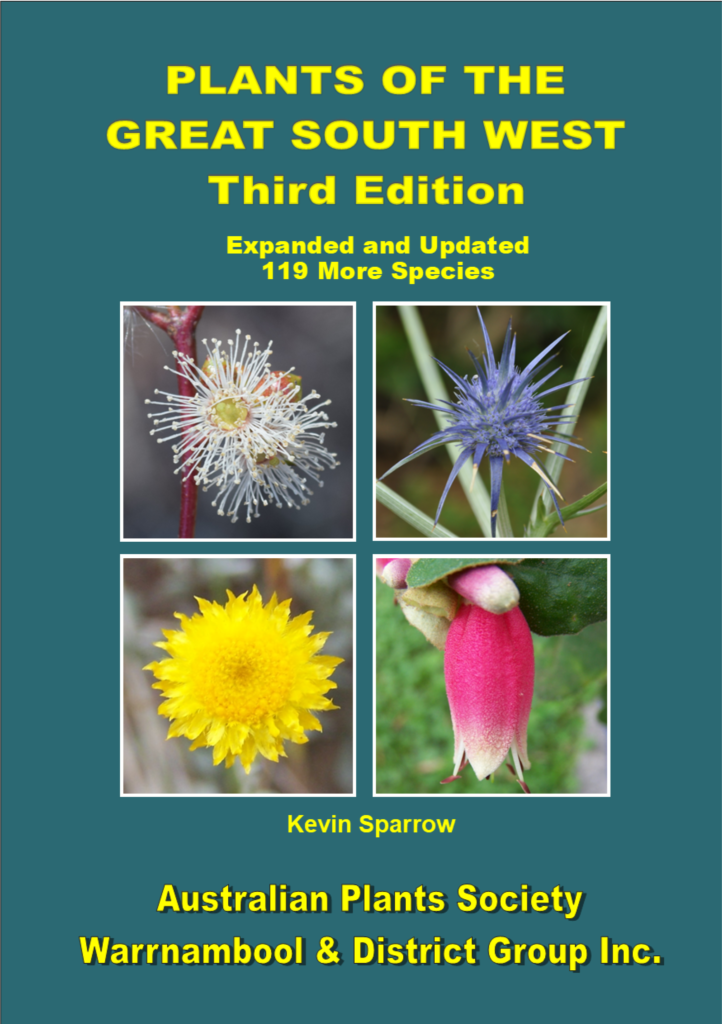
Ayesha Burdett, Landcare Facilitator
There is nothing more valuable than a good field guide. I have collected a few over the years and I have a few favourites in my collection. I like field guides that are easy to navigate, have great images and don’t require a scientific understanding of taxonomy.
This new edition of Plants of the Great South West by Kevin Sparrow ticks all of the boxes.
In this guide, plants are helpfully grouped into vegetation types such as large trees, climbers or wildflowers, with coloured tabs across the top of the pages to clearly indicate the group you’re examining. Some major groups, like lilies and daisies, are also highlighted in these groupings.
The photography of the plants is wonderful. I really appreciate that there are several views of each plant, indicating key distinguishing features that are described in the text.
The description for each plant is short and simple. The common name is always included alongside the scientific name, and just enough description is included to be able to figure out a plant identification. Additionally, there are tips for propagation and some information about Indigenous uses of native plants.
As well as all of these great features of the guide, there are several valuable introductory chapters contributed by local naturalists that are worthwhile reading to gain an overview of the geology, ecology and cultural history of the region, and a handy overview of some environmental weeds of the region.
This guide is published by the Australian Plants Society Warrnambool & District Group Inc., so there is an emphasis on coastal plants. However, many of the plants found on the volcanic plains and grasslands north of Warrnambool also extend into our region and this is a very useful – and usable – book for the Upper Hopkins.
Plants of the Great Southwest is available in Hamilton (Bellcourt Books or Slades Newsagency), Port Fairy (Ironbird Bookshop), Warrnambool (Collins Booksellers) or directly from the author (KSparrow93@gmail.com).
Investigating a Healthy Hopkins with Maroona and Willaura students
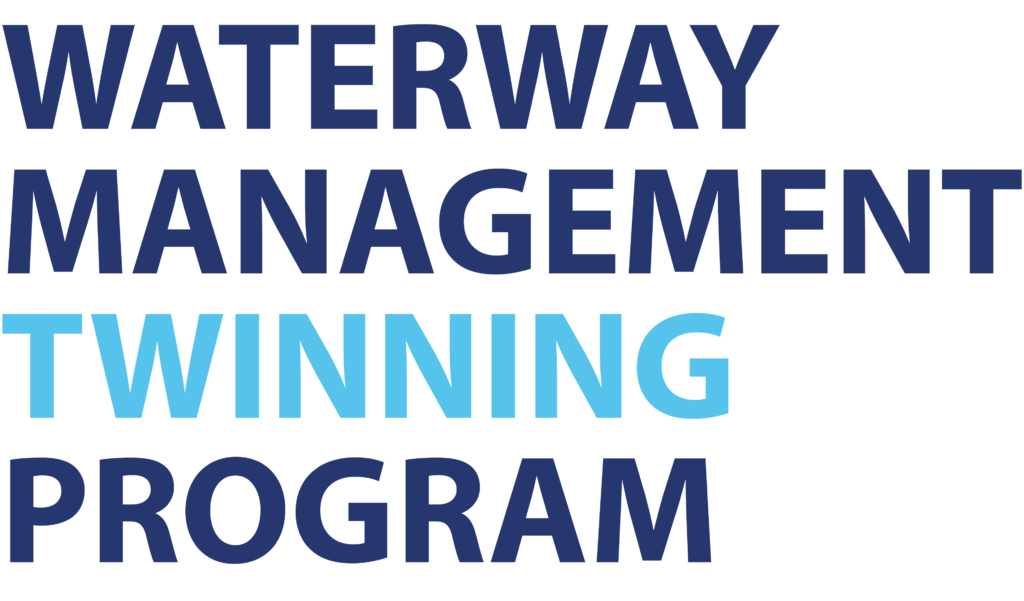
Ayesha Burdett, Landcare Facilitator
Last year, I participated in the Waterway Twinning Program, a structured mentoring program that focuses on improving the on-ground delivery of Victorian river and riparian restoration projects. I was partnered with Deirdre Murphy, the Regional Citizen Science Project Officer with the Corangamite Catchment Management Authority. Deirdre and I hatched a plan to conduct some outreach days with the local primary schools to learn more about the health of waterways in the region. After waiting for COVID restrictions to ease and students to return to school, the project was delayed until this year.
I spent a morning with students from each school, investigating salinity in their local water samples and waterbugs at two sites (Hopkins River near Maroona, and the Hospital Swamp in Willaura). At both schools, the students proved to be fantastic citizen scientists with excellent observation skills and great attention to detail. We tested a lot of different water samples from dams, puddles, salt lakes, garden ponds, bores and the kitchen tap and talked about why these different types of water have different salinities. Not surprisingly, the sample from the salt lake was extremely high and the samples of rainwater were very low.
Everyone enjoyed sampling for waterbugs, even if there were a few wet socks. I noticed that the bugs we collected in the river were a bit different to those collected at the swamp. These are two different types of habitat that can support diverse communities of macroinvertebrates and are important parts of the catchment ecosystem.
Many thanks to the teachers at both Willaura and Maroona Primary School for sharing your students and your enthusiasm for science and the natural world.
Hopkins river excursion: report from Maroona PS senior students
Last Friday Ayesha came to our school, she works at Upper Hopkins Land Management Group. We were told to bring a jar of our tap water but some people brought some dam water or creek water as well. We brought the water to measure salinity in the water to compare with the water from the river. Salinity is the salt in the water which is picked up in the mud.
After we had a look at all the instruments and bugs she had got from the river and on the table, we went down to the river and collected bugs in the river. We had some nets, the nets had a long white handle on the end. Grace held the bucket while everyone else shared the nets. After that we went back up to the table, some people did work in their booklet while others had a look at the table with bugs in it or the bucket.
After we looked at the bugs at the river, we had a sample of some bugs on the table that we had to find. We found a lot of small bugs, but we had to try and catch them to show what we found but they were really fast so it was a bit tricky. We all liked looking for bugs with the magnifying glass because it was very interesting. After we found the bugs we had to recognize which bug we found. The bug we found were; Mayfly Nymphs, Cased Caddis Larvae, Water Mites, Black Fly Larvae, Blood Worm or Chironomids, Glass Shrimps, Sideswimmers, Damselfly Larvae, Flatworms and Water Beetles. It was time to pack up just after everyone had a look at the bugs.
Then we packed up and went back to school. Ayesha told us that the river wasn’t too clean in that spot because of the road. We all had a great day and we learnt heaps of interesting facts about Hopkins River.
Farming & Grazing for Profit School – Hamilton

Richard Murphy, Land Health Coordinator
Many will already be aware of the Resource Consulting Service, Farming & Grazing for Profit School.
Some will know farmers who have completed the training and have learned how they have used this knowledge to improve their management and increase profit.
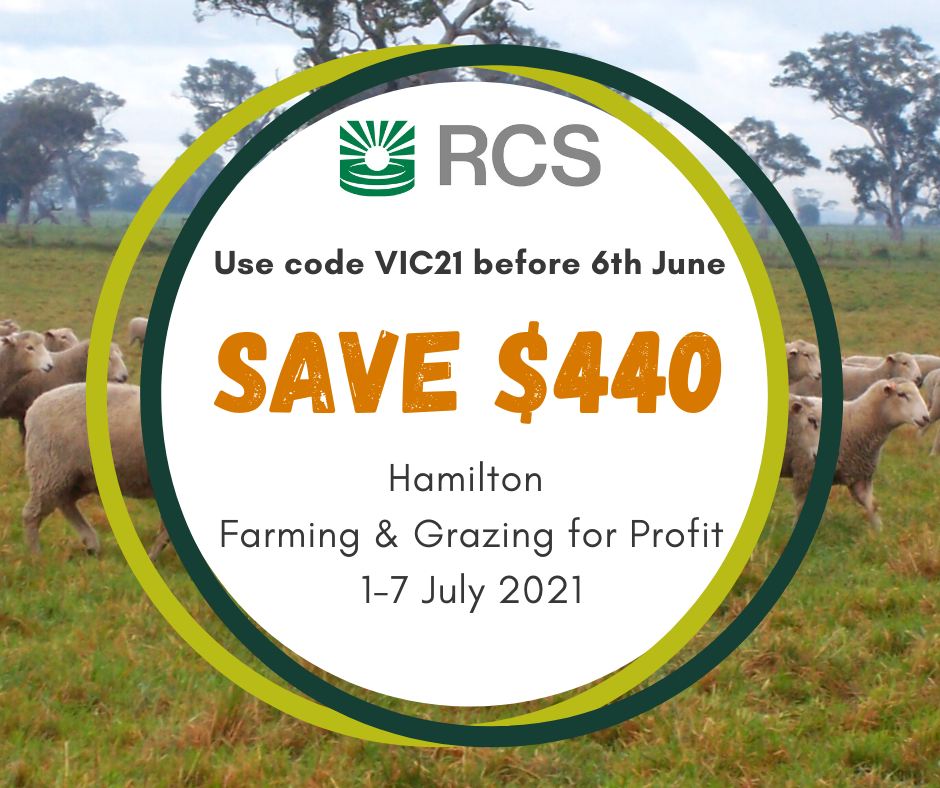
Everyone should know that the Farming & Grazing for Profit School will be held in Hamilton from Thurs. 1 July – Wed. 7 July.
This is a rare opportunity to participate that you may not want to miss. If you have been watching out for a school to be held in this area, you will know it has been a long wait. You may not want to let this opportunity pass.
Click below to learn more about the School or register online:
Use the code VIC21 for an early bird discount before 6 June!
To learn more or to register over the phone call 1800 356 004.

The Glenelg Hopkins Sustainable Agriculture project is supported by the Australian Government’s National Landcare Program.
Young Farmers Scholarships open for applications

The 2021 Upskill and Invest – Young Farmers Scholarships are open for applications.
You could recieve up to $10,000! Each scholarship recipient is eligible to receive up to $5,000 for training and study (Upskill), followed by up to $5,000 to put their new skills into practice (Invest).
If you are aged 35 years or younger, and have at least two years’ experience on-farm, you could be eligible to apply. To find out more visit vic.gov.au/youngfarmers.
The Government continues to support the next generation of farmers through a range of initiatives and provides opportunities for young people in agriculture to have their say, boost their skills and progress their careers.
The scholarship program builds on the commitments of the Agriculture Strategy to grow, modernise and promote the sector – helping to deliver the agriculture skills of the future and building on the Government’s goal to grow Victoria’s agriculture sector to $20 billion by 2030.
Since 2015, the Young Farmers Scholarship program has successfully supported 76 young farmers to develop their skills across a range of agriculture sectors.
Applications close at midnight on Sunday 6 June 2021.
Email youngfarmer.coordinator@agriculture.vic.gov.au for more information.
Farm Water Pipelines – Tips & Tricks

Clem Sturmfels, Land Management Extension Officer | Agriculture Services and Biosecurity Operations
Installing an efficient and effective farm water pipeline can be a complicated and expensive process. It is essential you select the correct components to ensure an adequate and reliable supply of water to all parts of the farm. Consider the following points when designing, installing, or upgrading your system:
Design & layout
- Design assistance is essential for all pipelines; you can’t guess this stuff
- Always “over design” your pipeline to allow for property expansion, build-up of residue and emergency use
- Use a range of pipe sizes to maximise flow rates and minimise cost; big flows need big pipes
- Doubling your pipe diameter increases the flow rate by 6 times
- Use a gravity supply for reliability and safety; tanks can be placed on a mound of earth to provide extra pressure
- Consider using a solar pump for reliability and reduced CO2 emissions.
Water quality
- Water quality can have a big impact on animal production, it is recommended you clean troughs on a regular basis
- A trough contaminated by algae, feed residues, straw or dust can reduce water consumption
- Avoid water with a salt concentration greater than 5,000 EC units (µS/cm).
Tank size
Storage tanks need to hold 4 days of water in reserve based on the peak demand over summer. Typical tank volumes to meet this requirement:
- For 500 sheep = 20,000 litres
- For 50 cattle = 20,000 litres.
Trough flow rates
Stock consume most of their daily water requirements over a 4 – 6 hour period. As a result, high flow rates are needed to meet this peak demand. Typical trough flow rates:
- For 500 sheep = 21 litres/minute
- For 50 cattle = 21 litres/minute.
Route selection
- Locate your main pipeline to access all critical parts of your farm such as a stock containment area, stockyards, house and garden
- Aim for straight lines where possible
- Avoid sudden changes in grade to reduce the risk of air locks
- Permanently mark the pipeline route on fence lines
- Mark the location of pipes, joiners and valves on your farm plan indicating depth and distance from other fixed objects.
Troughs, pipes and fittings
- A suitable trough for 500 sheep or 160 cattle would have 8 – 10 metres of accessible trough edge
- A long shallow, smooth sided concrete trough with rounded ends and a large bung for easy cleaning is recommended
- Place troughs on a raised pad to ensure good drainage and stability
- Only use high quality brand name pipe and fittings
- Use blue line pipe where pressure exceeds the pressure rating of normal pipe usually 60- 80m head
- Regular monitoring and maintenance of you pipeline, tanks and fittings is essential to ensure an adequate and reliable water supply.
Installation
- Ensure stored pipe is clear of mice, soil or other items that will clog the pipe
- Use trencher & bedding in rocky ground, suggest a minimum trench depth of 400 -500mm
- Use a pipe cutting tool to ensure clean, square ends to the pipe
- Follow fitting instructions for pipe joints carefully, some require hand tightening only, others require the use of multigrips or a pipe wrench
- Use a minimum of 6 turns of pipe tape between all threaded components
- Do not stretch pipe during installation; keep the pipe cool and loose to avoid failure
- If possible, leave the trench open and pressure test all your fittings.
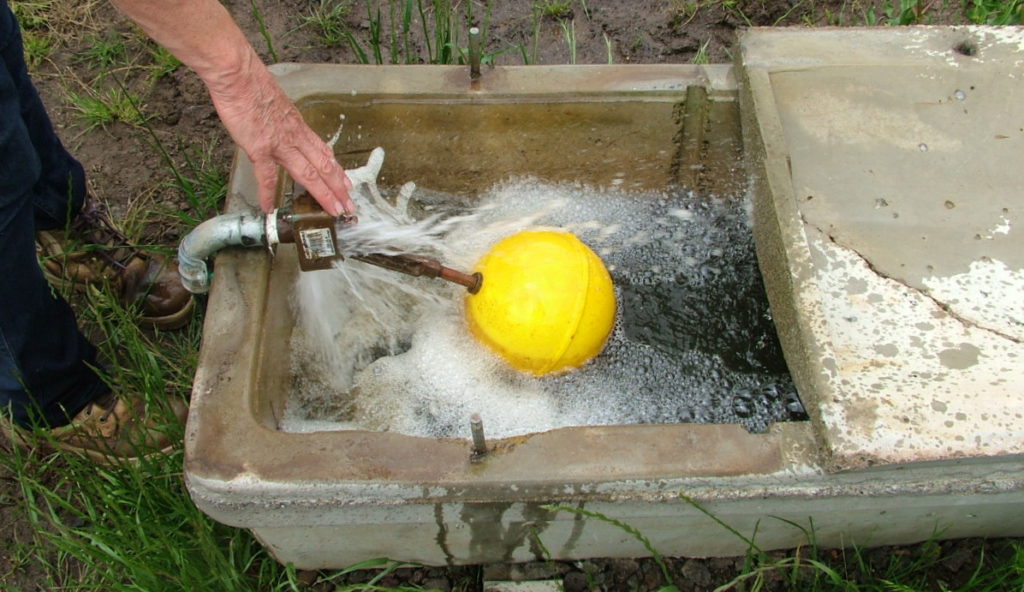
East Grampians Rural Pipeline updates
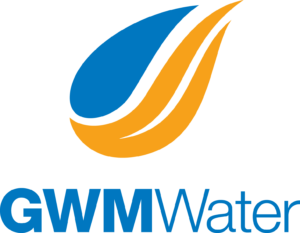
Adele Rohde, Manager Communications and Engagement
GWMWater and our contractor (Dunstans) are continuing to work through planning approvals and optimising the design for the East Grampians Rural Pipeline. GWMWater is also contacting landholders in the pipeline footprint to arrange Land Access Agreements in preparation for construction. Due to delays with planning approvals, construction is expected to start later than originally expected – at this stage not before October 2021.
Although the deadlines have closed to return Heads of Agreement, GWMWater is still accepting Expressions of Interest and Heads of Agreement from landholders with properties that front confirmed pipe alignments. To view the preliminary network visit gwmwater.org.au/egrp
We encourage any large water users who haven’t committed to get in touch as soon as possible so we can ensure pipe sizes are sufficient to support existing use and enable future developments.
GWMWater is issuing email newsletters quarterly to update landholders and interested people. To read previous editions, or to sign up for the newsletter, visit gwmwater.org.au/egrp
Perennial Pasture Systems Healthy Soils Program

Rob Shea, Project Manager
The Perennial Pasture Systems (PPS) was successful in gaining funding through the MLA Healthy Soils program to conduct six workshops to improve knowledge of soil management.
The program commenced in July 2019 when Dr Nathan Robinson from Federation University tackled the complex topic of soil types and management constraints. Nathan is originally from Moyston and was able to use his local knowledge to bring context to the subject.
For the second session, PPS invited Dr Belinda Hackney from NSW Dept of Primary Industries to present research findings on the effect of soil pH on clover growth. Participants also had a practical demonstration of assessing effective clover nodulation.
One more workshop was held before the Covid restrictions were imposed when Lisa Miller from Southern Farming Systems conducted a session on soil acidity. Lisa is also the overall coordinator of the program for MLA and has been very helpful to PPS.
After a break of over a year, the program recommenced in March 2021 when Lisa Warn from Warn Ag gave a comprehensive summary of soil testing which help group participants focus their soil testing plans. The session also launched the PPS soil test digitalisation project which has been funded by a Wimmera CMA Landcare Victoria grant. The project is being supported by Federation University and Dr Nathan Robinson showed graphics from the three pilot farms which had their data put into the system PPS hopes that the project will make soil test data collected over several years more accessible and will show changes in soil health over time.
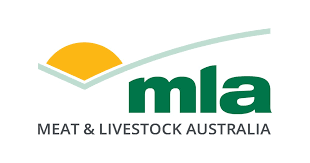
The topic of soil microbiology was the subject of the April session when Dr Helen Hayden from Agriculture Victoria provided an informative session on what is living in the soils and the conditions that allow them to thrive and improves soil health. The program will be completed in July when Cam Nicholson from Nicon Rural will conduct a review session and assist participants in their future soil health management.
Around thirty PPS members have participated in the Healthy Soils project and all have found it very useful in improving their knowledge of soil health.
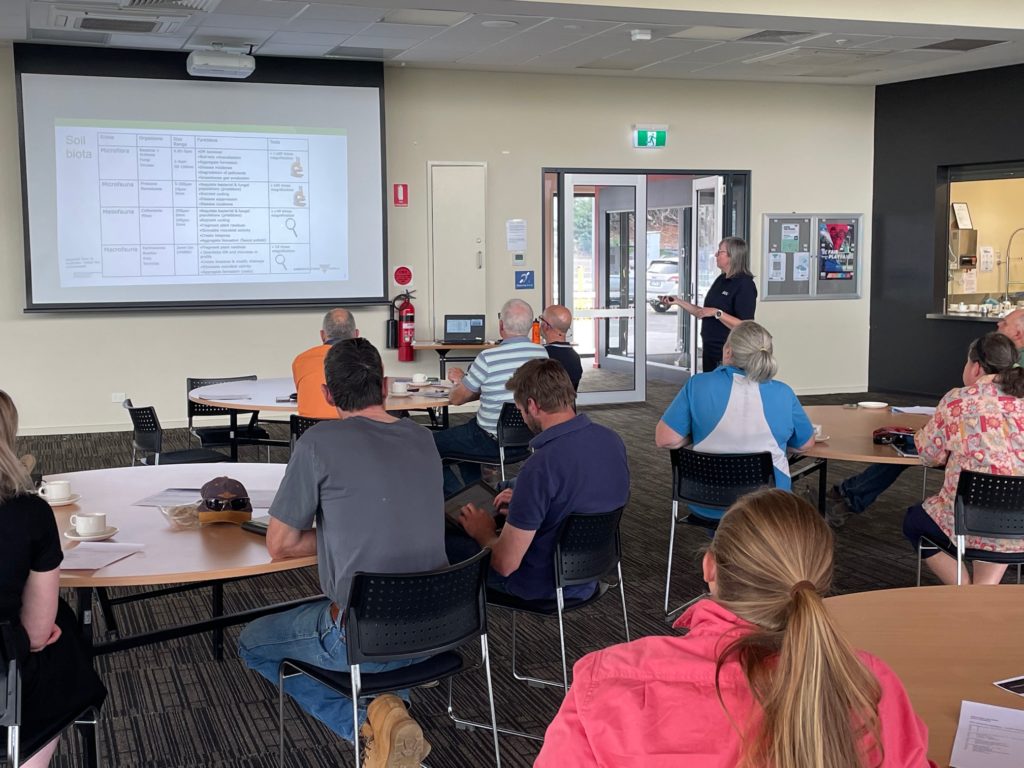
Dr Helen Hayden & PPS members at the Ararat Healthy Soils workshop. 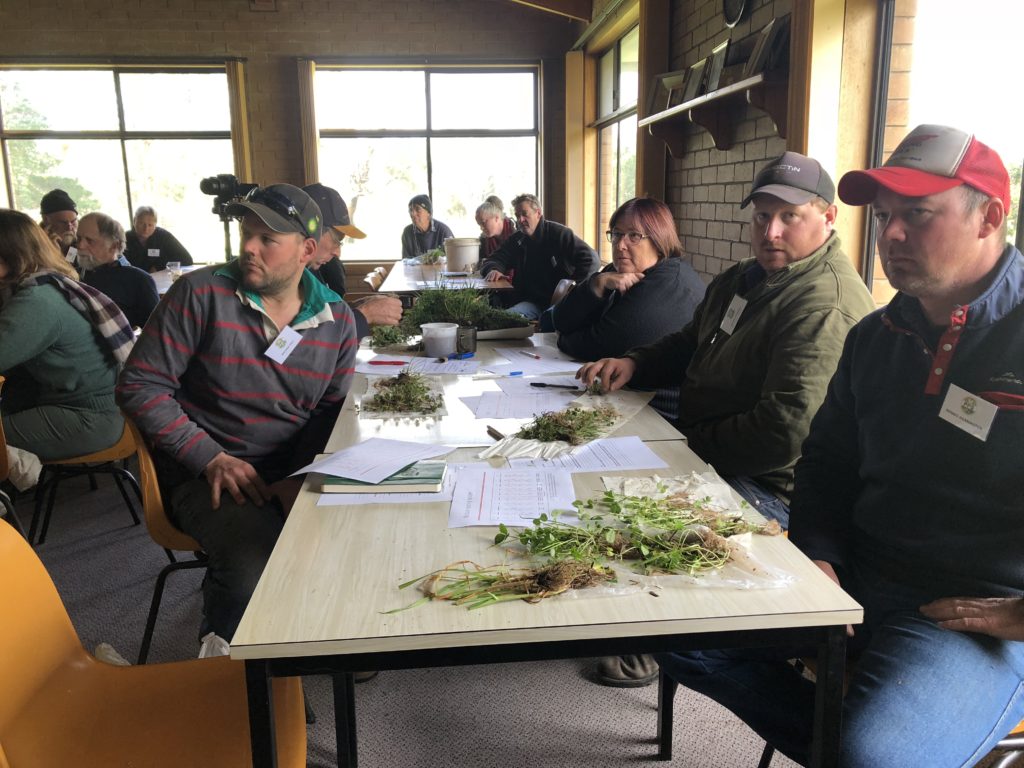
PPSmembers checking clover nodulation.
Southern Farming System updates
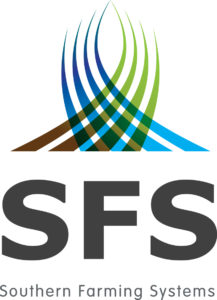
By Michelle McClure, SFS Events and Communications Coordinator
E:mmclure@sfs.org.auor M: 0488 600692
To date the mild season has been very agreeable for the sowing of the Southern Farming Systems trials across all sites in south west Victoria complete. The cropping team have been busy post sowing with baiting of slugs and mice (Inverleigh). Post emergent sprays are currently being applied, warning to those using clethodim that the efficacy can be affected by frosty conditions.
The soils, pasture and livestock team are busy doing assessments, soil tests and pasture cuts with some exciting online tools to come available in the next 12 months.
Women On Farms
SFS has been running advanced learning opportunities for Women on Farms with support from Glenelg Hopkins CMA with funding from the National Landcare Program since 2018 in the Lake Bolac and Hamilton regions. This year SFS is delivering a program called PayDirt. This program helps farmers to get the best return on investment for fertiliser and lime. It is a 3 session course that steps you through how to determine if a pasture is likely to respond to fertiliser or lime, how to interpret a soil test, how much to apply to optimise your investment and which paddocks to prioritise. Plus a 3 hour 1 on 1 session to support your fertiliser and liming plan suits your business and budget. With access to a simple computer tool to record your soil tests and see trends over time. Session One has been held across the regions and Session Two for the Lake Bolac Group will be on 21st June and Hamilton Group 24th June.
For more information contact Jessica Brogden, E: jbrogden@sfs.org.au or 0417 154 945 or checkout our short video on the program https://youtu.be/Ln0UX6wKXNg
Other PayDirt workshops are being run in the Mannibadar and Rokewood Regions.
Hyper Yielding Crops Results and Awards, Skipton
Hyper Yielding Crops Results and Awards evening at the Skipton Golf Club, Wednesday 16 June, 6.30-9.00pm. Please register with Rachel Hamilton, FAR.
Growers from around the country who chose to take part in the GRDC’s inaugural hyper yielding crops (HYC) awards initiative are about to find out just how hyper their crops really faired against fellow competitors.
Five seminars are planned to take place in June where winners of the GRDC’s HYC inaugural awards will be announced. There will be two awards per region – overall highest wheat yield and highest wheat yield based on % of yield potential.
To enable a ‘community’ approach to the HYC concept, the HYC awards program was established in 2020, the aim of which was to enable growers to benchmark the agronomic performance of their crops compared to a regional standard. Over 50 crops were entered into the 2020 wheat HYC awards spanning from the Albany Port zone through to Tasmania.
Jon Midwood of TechCrop is the HYC national extension coordinator. Mr Midwood along with each region’s project officer will present the awards and provide growers and advisers with a report interpretation including the potential yield calculations for each region. There will also be a chance for open discussion on lessons learnt in 2020.
Nick Poole, FAR Australia’s managing director and HYC project lead will co-present with research director Dr Kenton Porker and HYC field research officers on findings from the 2020 research trials. Mr Poole said “we are extremely excited to hear of the HYC’s inaugural award winners and the agronomic practices they adopted to reach these goals. Our year one trial results will not only focus on the yields achieved, but will also touch on climate statistics and what these meant for each crop, what management strategies worked best for disease management, the impact of artificial N and the interaction between genotype, environment and management (GEM) and how these interactions affected the phenology, biomass, final grain yields and overall profit margins. We hope that we can learn from these findings and as a result build on our yield potentials and margins in the years to come.”
The HYC awards will remain focused on wheat for 2021 and the project team is developing a plan whereby growers and advisers from outside the current regions can enter crops into the GRDC HYC awards programme. It is hoped that by expanding the HYC awards it will generate greater interest and collaboration in the quest for higher yields.
The GRDC’s Hyper Yielding Crops (HYC) initiative, led by FAR Australia, is a four-year investment spanning five states (Victoria, South Australia, Tasmania, New South Wales and Western Australia) which aims to push the economically attainable yield boundaries of wheat, barley and canola.
The HYC initiative involves five research centres of excellence, and attached to each of these are five focus farm paddock trials and an innovative grower network charged with taking research and development learnings from small plot to paddock scale. For the second year, growers are being invited to join these networks and host paddock-scale trials on their properties to enable a “seeing is believing” participatory approach to the research.
The HYC Focus Farm paddock strips, innovative grower network and awards involve Techcrop working with the Centre for eResearch and Digital Innovation (CeRDI) at Federation University Australia and four farming groups across the HRZ these are Southern Farming Systems (SFS) in Tasmania and Victoria, MacKillop Farm Management Group (MFMG) in SA, Riverine Plains Inc in NSW, and Stirlings to Coast Farmers in WA. Growers, advisers and others wishing to become involved in the HYC initiative can contact their respective state project officers:
- Victoria – Ashley Amourgis of SFS, aamourgis@sfs.org.au
- Tasmania – Bret Davey of SFS, bdavey@sfs.org.au
- SA – Jen Lillecrapp of MFMG, jen@brackenlea.com
- NSW – Kate Coffey of Riverine Plains Inc – kate@riverineplains.org.au
- WA – Nathan Dovey of Stirling to Coast Farmers, ceo@scfarmers.org.au
For further information on the Hyper Yielding Crops project, please visit https://faraustralia.com.au/hyper-yielding-crops/
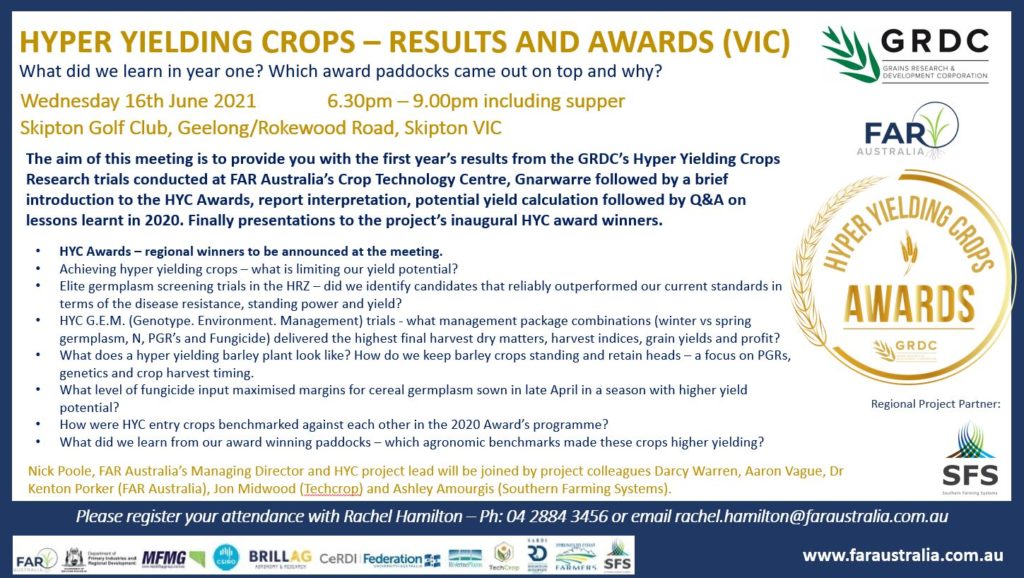
Photo gallery
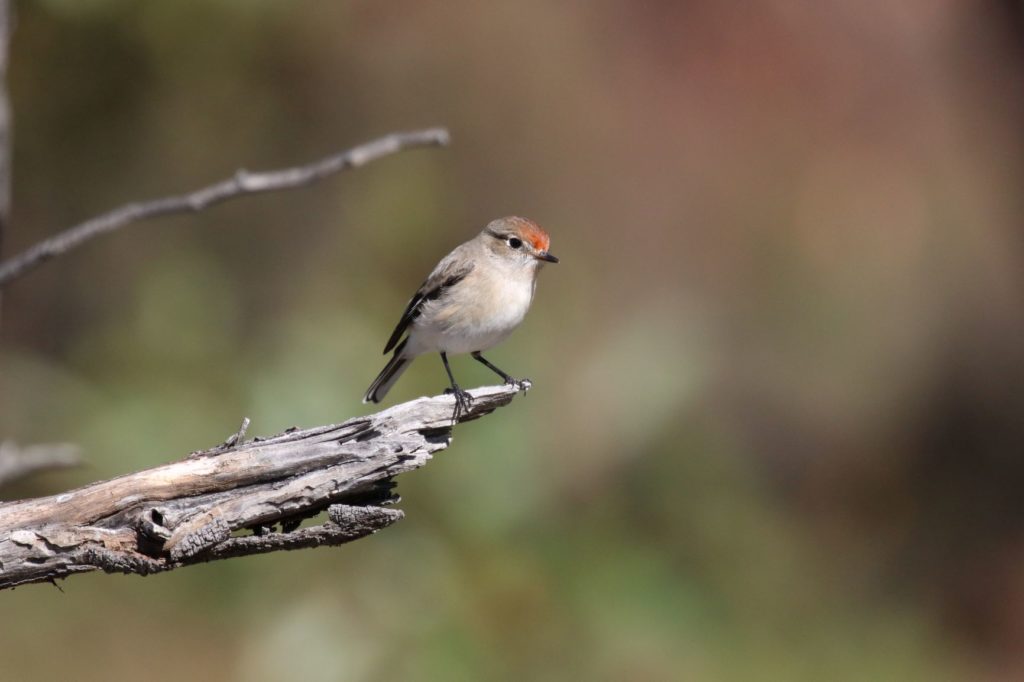
Red-capped Robin – Petroica goodenovii. Red-capped Robins are found across arid Australia and the Ararat Hills and nearby areas are the southern extent of their range. 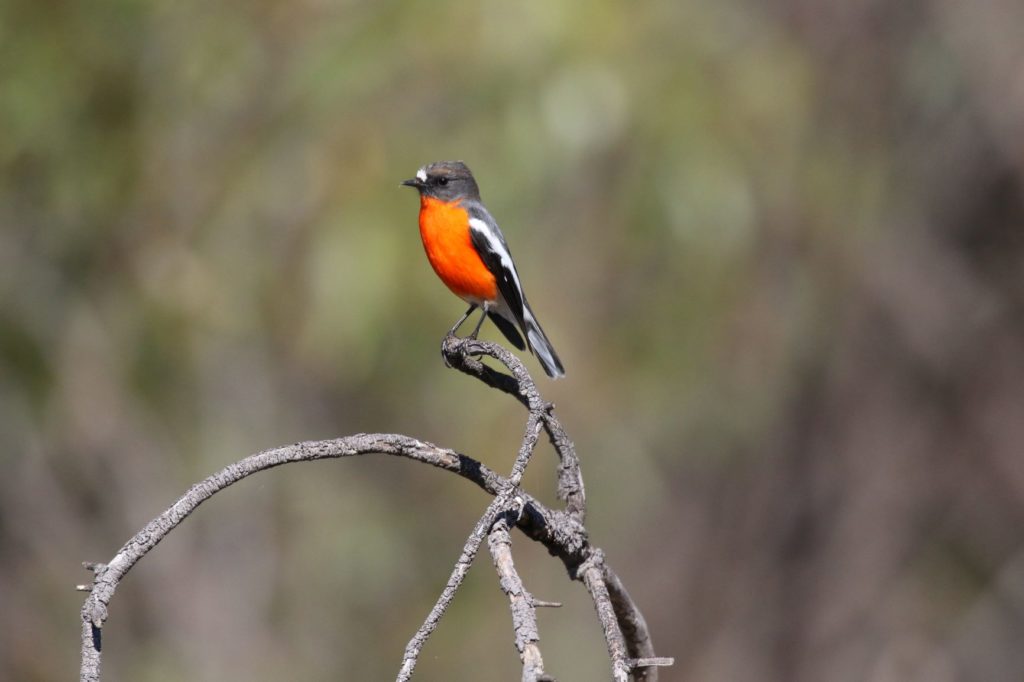
Flame Robin – Petroica phoenicea. Flame Robins have returned to local farms in recent weeks after breeding in the higher areas of the Grampians and the Pyrenees over the summer months. 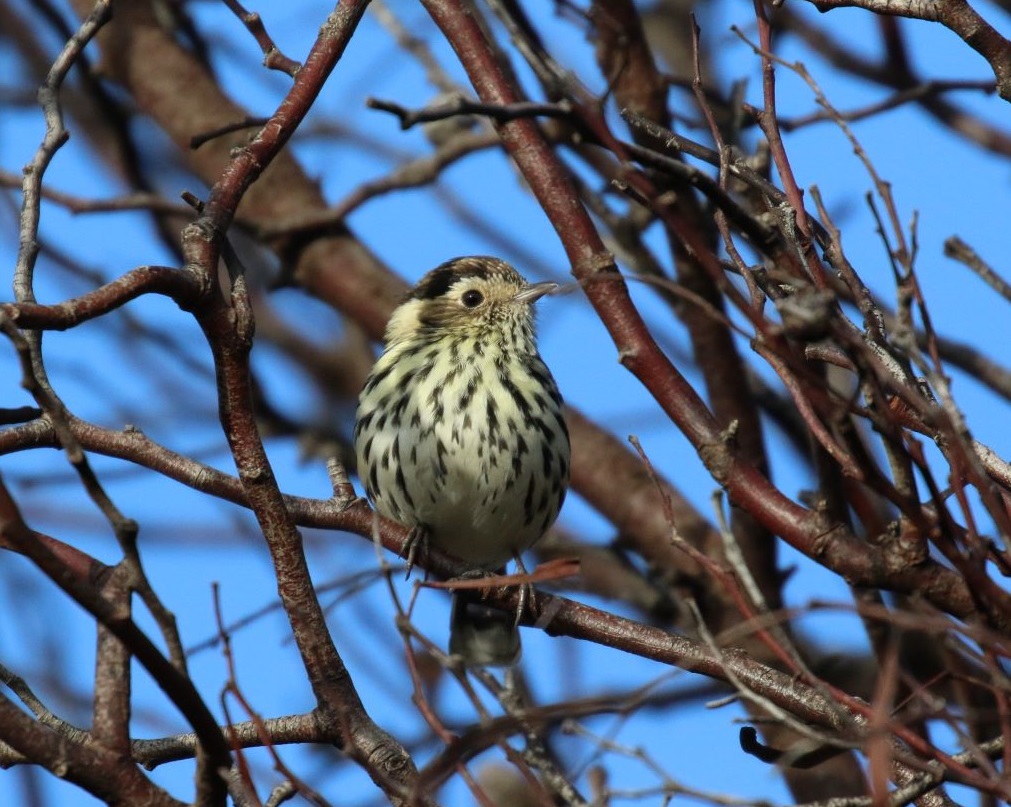
Speckled Warbler – Pyrrholaemus sagittatus. A small, shy and rare bird to the Ararat Hills that will feed on the ground in dry woodlands with fallen timber 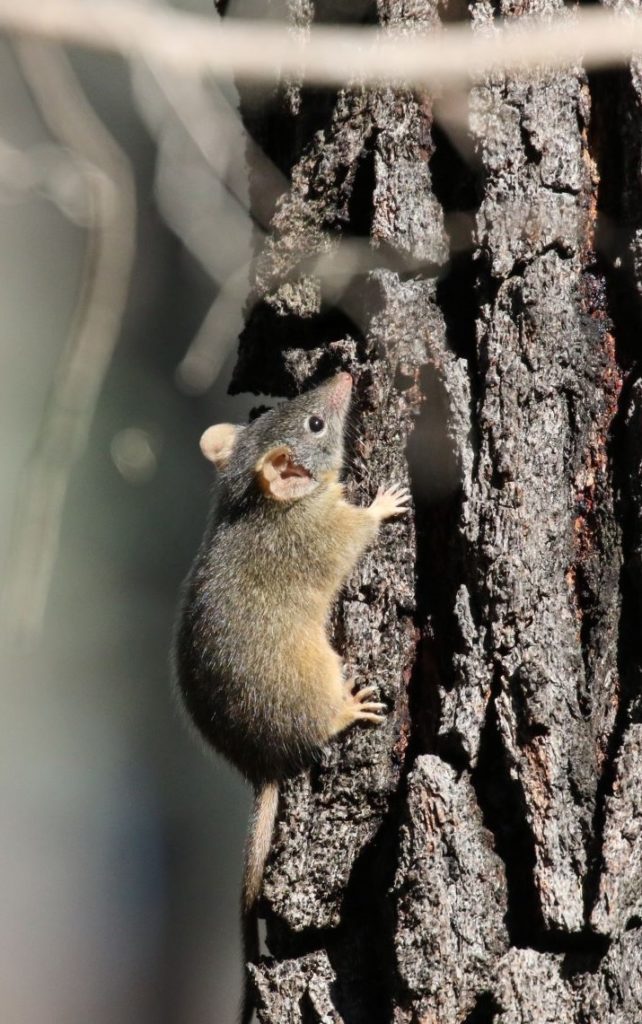
Yellow-footed Antechinus – Antechinus flavipes. A small carnivorious marsupial that will largely feed during the day in trees and amongst fallen timber.
Reconciliation Week Art Exhibition

The 2021 Lake Bolac Eel Festival Reconciliation Week Art Exhibition is now open at the Lake Bolac Information and Business Centre. Gunditjmara Elder Aunty Adeline Thomas welcomed guests to Country and the CEO of the Ararat Rural City Dr Tim Harrison officially opened the exhibition last Thursday evening.
This year the exhibition features the work of Warrnambool-based Indigenous artist and cultural educator Sherry Johnstone. Sherry’s sixteen painted works reflect a range of styles and stories, and many are for sale. The exhibition also features a number of small works completed by Lake Bolac Kindergarten and Lake Bolac College students.
Sherry Johnstone has worked for many years as a Koori Educator with kindergarten and primary school students. In 2014, she returned to her childhood love of drawing. Sherry has produced commissioned and original art, community projects, and an Aboriginal Early Years Activity resource that is being utilised throughout Victoria. Currently she is Curator of Cultural Engagement at Warrnambool Art Gallery.
“All the things I have experienced in my life whether it be good or bad, it has shaped me to be where I am and who I am today. I am stronger in my identity and more resilient, embracing and honouring my aboriginality, feeling proud and spiritually connected to my ancestors and country. I include all of these elements within my creations and am passionate about making a difference.”
– Sherry Johnston
More details on Sherry’s work can be found at spiritandsoulcreations.com.au.
National Reconciliation Week (27 May to 3 June) commemorates two significant milestones in the reconciliation journey — the successful 1967 referendum, and the High Court Mabo decision. National Reconciliation Week is a time for all Australians to learn about our shared histories, cultures, and achievements, and to explore how each of us can contribute to achieving reconciliation in Australia. The theme for 2021 is “More than a word. Reconciliation takes action.”
The exhibition is supported by funding from Reconciliation Victoria and will be open till mid-August.
www.eelfestival.org.au
festival@eelfestival.org.au
www.facebook.com/eelfestival/

Meanderings and reflections
It was a wild week to be surveying and checking water quality. I don’t mind working when it is drizzling rain, but I got walloped by the heavy rainfall last Tuesday morning. On the sunny days, I spotted ducks and dusky moorhens enjoying the water.
Several of the minor tributaries are still dry after summer, but I expect that most of them will be flowing again in a few weeks.
Water monitoring results
You can view the EC data in the table below, or click on the link to download a file. Numbers in bold exceed 6,000 EC μS/cm.
EC levels for livestock water supplies. Value given in brackets for each type of livestock is the EC level at which production decline begins: Beef cattle (6,200 EC μS/cm), lactating ewes and weaners (6,000 EC μS/cm), dry sheep (9,300 EC μS/cm)), horses (6,200 EC μS/cm), Pigs (3,100 EC μS/cm), poultry 3,100 EC μS/cm).
